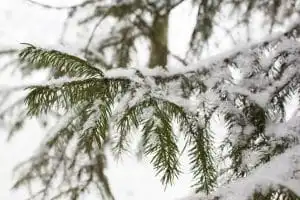From early cold spells to mid-season ice storms to the last of the snow showers, our trees and plants encounter a great deal of stress during the winter months. We tend to think of the trees in our yard as sturdy stalwarts that handle the harshest elements simply because they are so big. But that’s not the case. These landscape landmarks feel the full force of the season. Find out how to protect trees in winter and help them withstand another year of inclement weather.
Common Concerns
You put a lot of time and money into your landscaping, so you don’t want to lose any trees or shrubs during the winter season. Extreme cold temperatures aren’t the only wintertime worry. Here are some things to consider when putting a plan in place to protect these lovely focal points in your yard.
- Bitter cold and fluctuating temperatures
- Wind that can break branches and dry out foliage
- Sunscald, which appears as sunken, dried, or cracked areas of dead bark
- Branch and limb breakage, even toppled over trees, from the weight of heavy snow and ice
- Winter dieback
- Hungry animals like deer, rodent, and insects that are in search of food
- Salt damage
Beating the Big Chill
Although trees are dormant during the winter months, they are not safe from the extreme weather conditions. Fortunately, you can take steps to protect trees in winter. Fall is the best time to start, but even after the cold arrives, it’s never too late to put a plan in place. Create a winter prep checklist that includes proper year-round maintenance. This includes knowing when to prune, water, fertilize, and mow–and when not to. Seek out the advice of lawn and tree-care experts to make it easier on yourself and eliminate the guesswork. We can provide you with some suggestions here.
What You Can Do to Protect Trees in Winter
Wrapping tree trunks. Younger trees are more susceptible to damage from frost, ice, and sunscald. To protect bark, wrap burlap cloth around the trunk, using rope or twine to keep it in place. Newly planted trees should be wrapped for at least the first two winters, and if they are thin barked, a few more years after that. Add another layer of protection by surrounding the trunk with a wire or mesh or cage. This keeps out animals that need a nibble during the sparse food months. Store-bought repellants also keep rodents and deer away from trees.
Water and drainage. Trees store water to get through the winter months, so provide them with enough water until the ground freezes. Also, make sure you have fixed any drainage issues before the first frost. Soaked soil can freeze and thaw many times throughout the season, especially when temperatures fluctuate from day to night. This causes the ground to repeatedly expand and contract, which can push roots out of their protected places, even above ground.
Positioning. You don’t have control over the weather, but you do have control over where you plant trees and shrubs. Always choose trees that are native to the area’s hardiness zone. Plant these new additions in sheltered areas or areas that are less exposed to excessive wind or sun. You can create a more sheltered environment for younger trees by building a windbreak or temporary fence with burlap or other materials.
Proper pruning. When performing winter prep, prune only after trees have entered the dormancy stage. This prevents new growth that would be more susceptible to the colder weather. Cut back weak or dead branches, and remove the more vulnerable limb of a pair that forms a deep “V” shape.
Mulching provides a protective covering when placed at the base of tree trunks. It helps the soil retain moisture and keeps the ground temperature more consistent. Cover the base under the dripline with natural mulch about three to five inches thick. And be sure to leave a small space between the mulch and trunk so that burrowing animals and insects won’t be tempted to feed on the bark.
Throughout the season, clear snow off of smaller trees and shrubs with a broom before it freezes and becomes heavy enough to damage or break branches. Leave ice on limbs alone because you may inflict more damage when you try to remove it. Immediately after winter, perform an inspection to repair any damage as soon as possible.
We Are Here to Help
A little preventative maintenance goes a long way when it comes to protecting your trees in the winter. Call Free Spray Lawn Care at 419-529-5296 and let us help your landscaping weather whatever the season brings.



Comments (0)
Thanks for your comment!
Thanks for your feedback! Your comments have been successfully submitted! Please note, all comments require admin approval prior to display.
Error submitting comment!
There is a problem with your comment, please see below and try again.